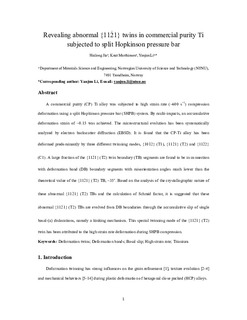| dc.contributor.author | Jia, Hailong | |
| dc.contributor.author | Marthinsen, Knut | |
| dc.contributor.author | Li, Yanjun | |
| dc.date.accessioned | 2019-01-09T12:33:53Z | |
| dc.date.available | 2019-01-09T12:33:53Z | |
| dc.date.created | 2019-01-07T18:52:53Z | |
| dc.date.issued | 2019 | |
| dc.identifier.citation | Journal of Alloys and Compounds. 2019, 783 513-523. | nb_NO |
| dc.identifier.issn | 0925-8388 | |
| dc.identifier.uri | http://hdl.handle.net/11250/2579953 | |
| dc.description.abstract | The deformation behavior of Ti alloys during conventional deformation, such as rolling and compression,have been extensively investigated, while it is less understood during high strain rate deformation. In thepresent work, a commercial purity (CP) Ti alloy was subjected to high strain rate (~600 s 1) compressiondeformation using a split Hopkinson pressure bar (SHPB) system. By multi-impacts, an accumulativedeformation strain of ~0.15 was achieved. The microstructural evolution has been systematicallyanalyzed by electron backscatter diffraction (EBSD). It is found that the CP-Ti alloy has been deformedpredominantly by three different twinning modes, {1012} (T1), {1121} (T2) and {1122} (C1). A largefraction of the {1121} (T2) twin boundary (TB) segments are found to be in connection with deformationband (DB) boundary segments with misorientation angles much lower than the theoretical value of the{1121} (T2) TB, ~35. Based on the analysis of the crystallographic nature of these abnormal {1121} (T2)TBs and the calculation of Schmid factor, it is suggested that these abnormal {1121} (T2) TBs are evolvedfrom DB boundaries through the accumulative slip of single basal-⟨a⟩dislocations, namely a kinkingmechanism. This special twinning mode of the {1121} (T2) twin has been attributed to the high strainrate deformation during SHPB compression, which is helpful for understanding the deformation andtwinning behavior during high strain rate deformation. | nb_NO |
| dc.language.iso | eng | nb_NO |
| dc.publisher | Elsevier | nb_NO |
| dc.title | Revealing abnormal {11-21} twins in commercial purity Ti subjected to split Hopkinson pressure bar | nb_NO |
| dc.type | Journal article | nb_NO |
| dc.description.version | submittedVersion | nb_NO |
| dc.source.pagenumber | 513-523 | nb_NO |
| dc.source.volume | 783 | nb_NO |
| dc.source.journal | Journal of Alloys and Compounds | nb_NO |
| dc.identifier.doi | https://doi.org/10.1016/j.jallcom.2018.12.092 | |
| dc.identifier.cristin | 1651875 | |
| dc.description.localcode | This is a submitted manuscript of an article published by Elsevier Ltd in Journal of Alloys and Compounds, 19 December 2018. | nb_NO |
| cristin.unitcode | 194,66,35,0 | |
| cristin.unitname | Institutt for materialteknologi | |
| cristin.ispublished | true | |
| cristin.fulltext | preprint | |
| cristin.qualitycode | 1 | |
